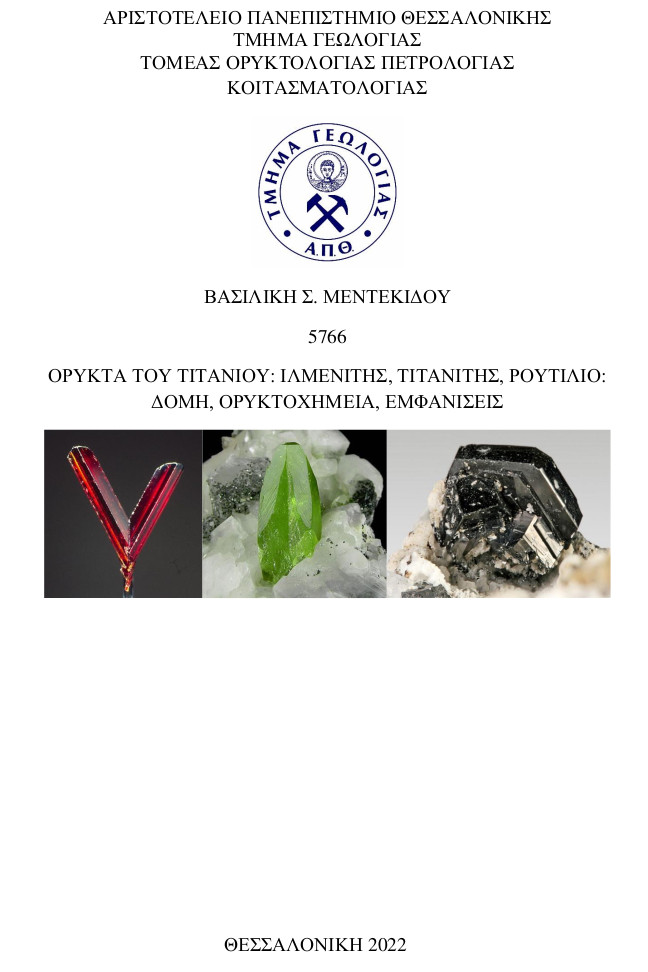
Ορυκτά τιτανίου: ιλμενίτης, τιτανίτης, ρουτίλιο. Δομή, ορυκτοχημεία, εμφανίσεις = Titanium minerals: ilmenite, titanite, rutile. Structure, mineral chemistry, occurrences.
Περίληψη
Titanium is a chemical element that is widely used in our lives, especially in recent decades with the development of innovative mining and processing methods. The aim of this Bachelor thesis is the review of three titanium minerals: ilmenite, titanite and rutile. After an extensive analysis of titanium as a chemical element, information is presented regarding the formation, structure, chemical composition and appearance of the minerals mentioned above, in various geotectonic environments and rocks. In the end, the importance of titanium and its minerals in various scientific fields, as well as in industry are pointed out. In addition to being a key element in many objects that are essential to our lives, titanium is used in more advanced applications such as aviation and biomedicine due to its unique properties. That is why the development of more economical and more efficient mining and processing methods is crucial.
Πλήρες Κείμενο:
PDFΑναφορές
Αγγλική βιβλιογραφία
Bhogeswara Rao, D., & Rigaud, M. (1975). Kinetics of the oxidation of ilmenite. Oxidation of Metals, 9(1), 99-116.
Brooks, K. (2019). Minerals explained 56: Sphene (titanite), Geology Today, 35(1), 196-200.
Deb, T., & Mallik, J. (2022). Successive stages of interaction between felsic and mafic magma in the Bundelkhand craton, India: A petrographic investigation. Journal of Earth System Science, 131(1), 1-18.
Di Paola, A., Bellardita, M., & Palmisano, L. (2013). Brookite, the least known TiO2 photocatalyst. Catalysts, 3(1), 36-73.
Hayden, Leslie A., E. Bruce Watson and David A. Wark, 2008, A Thermobarometer for Sphene (Titanite), Contributions to Mineralogy and Petrology, 155(4): 529-540.
Kiss,G., Zaccarini, F. (2020). Compositional Variations of Titanite: A Possible New Tool for Cyprus-Type Volcanogenic Massive Sulfide Deposit Prospecting, Geosciences, 10(8), 1
Kohn, Matthew J., 2017, Titanite Petrochronology, Chapter 13 in Petrochronology: Methods and Applications, Reviews in Mineralogy and Geochemistry, Volume 83, ed. by. Matthew J. Kohn, Martin Engi and Pierre Lanari, Mineralogical Society of America 419-442.
Lindsley, D.H. 1976a. The crystal chemistry and structure of oxide minerals as exemplified by the Fe-Ti oxides. p. L-I-L-60. In D. Rumble III (ed.) Reviews in mineralogy. Vol. 3. Oxide minerals. Mineralog. Soc. Amer., Washington, De.
Meinhold, G. (2010). Rutile and its applications in earth sciences. Earth-Science Reviews, 102(1-2), 1-28.
Milnes, A. R., & Fitzpatrick, R. W. (1989). Titanium and zirconium minerals. Minerals in soil environments, 1, 1131-1205.
Spandler, C., Hammerli, J., Sha, P., Hilbert-Wolf, H., Hu, Y., Roberts, E., & Schmitz, M. (2016). MKED1: a new titanite standard for in situ analysis of Sm–Nd isotopes and U–Pb geochronology. Chemical Geology, 425, 110-126.
Tilton, G. R. and M. H. Grunenfelder, 1968, Sphene: Uranium-Lead Ages: Science, 159: 1458-61.
V. B. Fetisov, L. I. Leont'yev, B. Z. Kudinov, and S. V. Ivanova, Izv. Akad. Nauk SSSR, Metal 2, 47 (1968) (Russ.); Russian Metallurgy (Metally) 2, 35 (1968) (Engl. transl.).
Veiga, C., Davim, J. P., & Loureiro, A. J. R. (2012). Properties and applications of titanium alloys: a brief review. Rev. Adv. Mater. Sci, 32(2), 133-148.
Wilson, N. C., Muscat, J., Mkhonto, D., Ngoepe, P. E., & Harrison, N. M. (2005). Structure and properties of ilmenite from first principles. Physical review B, 71(7), 075202.
Woodruff, L. G., Bedinger, G. M., & Piatak, N. M. (2017). Titanium (No. 1802-T). US Geological Survey.
Ελληνική Βιβλιογραφία
Θεοδωρίκας, Σ. (2013). Ορυκτολογία–Πετρολογία.
Χριστοφίδης Γ., Σολδάτος Τ. (2011). Οπτική Ορυκτολογία
Διαδικτυακές πηγές:
https://www.arkraregems.com/
https://www.britannica.com
https://cargohandbook.com
https://www.gemsociety.org
https://www.geolab.unc.edu/
https://geology.com
https://www.mindat.org
https://www.rmag.org/
https://ui.adsabs.harvard.edu/
http://webmineral.com
Εισερχόμενη Αναφορά
- Δεν υπάρχουν προς το παρόν εισερχόμενες αναφορές.
